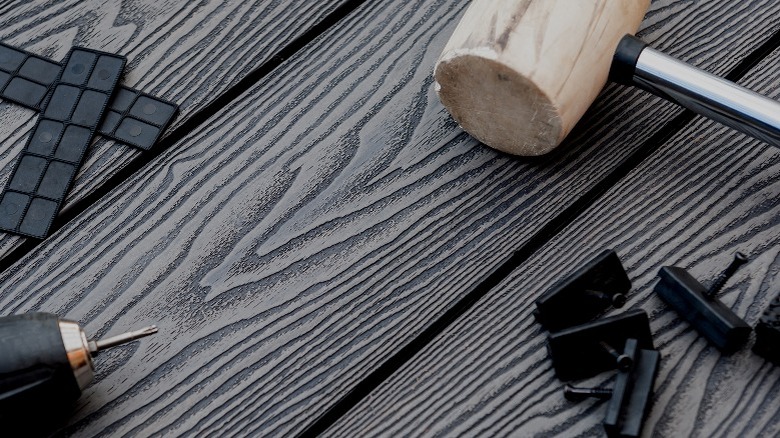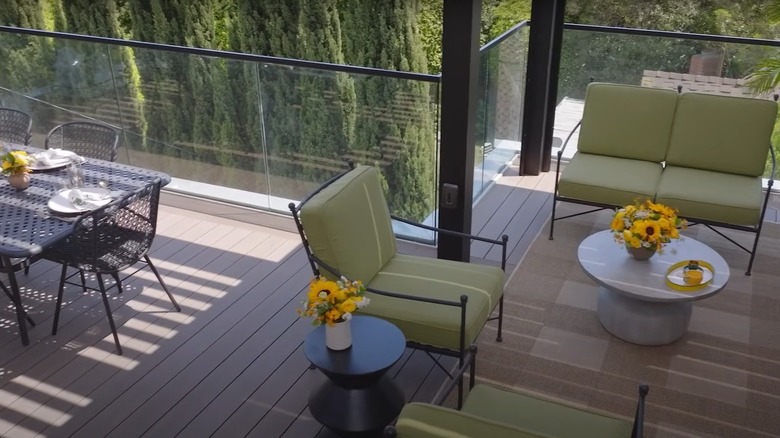The Deck Color That Property Brothers' Drew Scott Recommends Avoiding
Deck colors no longer have to be some shade of brown that looks like real wood. Modern-style materials can be black, gray, or white, as long as the deck color provides a complement to the main color of your home's exterior. Before you select one of these modern options, though, Drew Scott of HGTV's "Property Brothers" has a reason why you may not want to use black as your primary deck color.
"If you do black, for example, you're gonna be seeing the dirt a lot easier," Drew Scott said in a video on the Drew & Jonathan YouTube channel. Most people know that using solid black makes it difficult to hide dirt, whether you are trying to select a car color or a kitchen cabinet color that hides dirt. The black paint on a deck has the same issue. It's going to need cleaning more often to avoid showing dirt, water spots, and pollen.
You may need to go with a dark color on the deck to contrast a light-colored home, though. Scott said he doesn't mind using a dark material on a deck — as long as it isn't black. "I went with an English walnut," he said. "It's a sophisticated color. It's a natural tone. But it's not too light."
Other reasons to skip installing a deck that's black
Beyond showing dirt, a few other reasons exist for avoiding using black for your deck material. If your deck receives direct sunlight all day, the black color could cause the surface to become extremely hot, although this issue would potentially apply to all dark colors. Dark-colored material absorbs and retains more heat from the sun than lighter material, meaning its temperature could become dangerously high. According to an experiment by Cascade Fence & Deck, a black-colored deck can reach 200 degrees Fahrenheit on a sunny, 78-degree day. That's about 10 degrees more than a dark-brown material and about 33 degrees higher than a light-brown material. With the material getting so hot, it could be dangerous for people walking on it with bare feet or pets who are walking or lying on it.
If you install a composite decking material that's black, you may notice scratches over time. Against the dark background, the scratches can be quite noticeable. The good news is that, when new, most composite materials will resist scratches unless an improper installation occurs. Additionally, composite decking is more resistant to scratches than wood, and if scratches appear from typical wear and tear, you can try to repair them. However, composite decking material nearly always will show scratches as it ages no matter how careful you are.
Why Drew Scott went with a dark-color PVC material for his deck
The English walnut color Drew Scott chose for his deck makeover is a dark, warm brown color. He didn't have to worry much about the dark color overheating in the sun because his deck area has significant shading with its pergola roof.
The material he used is low maintenance and easy to clean. "It looks like real wood, but it's never going to stain or fade the way that you would have with natural wood," Scott said in the video. "And they have all different colors. The number of choices I had was amazing."
The TimberTech Advanced PVC material that he selected for the deck uses recycled polymers rather than wood fibers. It consists of 60% recycled materials, and it has a 50-year fade and stain warranty, providing a high level of value over time. "For me, it's about function ... and it's about style," Scott said of his outdoor space and deck. "You can see, I now have my favorite space in the entire house. [It] has all of those things right here." The cost to build a deck averages from $15 to $35 per square foot, so having a material that lasts is a great investment.


